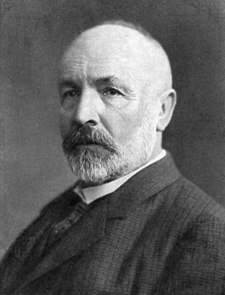
An odd campaign emerged in the 19th century – the effort to reduce numbers to sets. This brings us back, though in a rather different light, to the question with which we opened: what is a number?
The simplest
possible kinds of numbers are the counting numbers, those we tick off from one
to ten on our fingers. There can be no doubt that they are numbers, they are
the paradigm, they are at heart what we mean by “numbers.” Thus, whether
anything else is a “number” is, if you will, a question about the family
resemblance between the counting numbers and that other sort.
Whatever else
is a number: three is a number!
“Is pi a
number?” means, “does pi have a close family relationship to three?”
“Is i a number?” means the same.
But in the 19th
century, for the first time, mathematicians and logicians started wondering,
not idly but in all workaday seriousness, what it means to call three a number.
They decided
that numbers were special sorts of set. The number zero is the null set,
sometimes indicated by this notation:∅.
Spelling that
out, the set of nothing is different from the set consisting only of that set; ∅ is different from {∅}. And so we
have gone from 0 to 1. We can keep going in regular counting order. Two is the
set consisting of both of the above sets. Three is the set consisting of all of
the sets thus far named. And so forth for as long as we have patience. And we have built the natural numbers, a set
of these strange formulations, building it out of … nothing.
It is possible
to re-define the other sorts of numbers we’ve been discussing using set
theoretic conceptions, and a good deal of ingenuity has been expended on this. But
it was with his venture into infinity that one of the founders of set theory, Georg
Cantor, blew everybody’s mind. [By the way, Cantor’s doctoral adviser was Karl
Weierstrass. That’s a name we’ve encountered here before. He’s the fellow who
figured out how to re-work calculus without reference to those dubious
infinitesimals.]
Cantor worked on the concept of the
equivalence of sets, or the one-to-one relationship between the items in one
set and the items in another. It seems
obvious, for example, that the set of odd positive integers is equivalent to
the set of even positive integers. We can line them up in a one-to-one
correspondence this way:
2 - 1
4 - 3
6 -
5
and so forth.
We can keep pairing them off forever, without embarrassing themselves or the
mathematicians.
What about the
set of all odd positive integers’ numbers and the set of all positive integers?
This seems different. Surely, we say at first thought, the set of odd positive
integers is only one-half as large as the set of all positive integers!
But no, our
mind is accustomed to dealing with finite groupings, and here the difference between infinite
and finite groupings leads us astray.
If we
understand the equivalence of sets as the possibility of this sort of one-to-one
correspondence, we’ll soon have to agree that the odd integers and all integers
are equivalent sets. Line them up and see!
1 - 1
2 - 3
3 - 5
4 - 7.
At what point
will we run out of odds that we can put on the right side of that column to
match the newest integer, odd or even, on the left? Never. Thus, the two infinite sets are
equivalent.
Does this mean
that every infinite set is equivalent to every other? No. In particular, by the same standard the set of
all integers is decidedly not
equivalent to the set of all points on a line segment: any line segment.
Let’s prove
this. Suppose we’re discussing a line segment one unit long. It doesn’t matter of
course what the unit is: a foot, a meter, a mile. We will represent the point
on the leftward most end of this segment as 0, the midpoint as 0.5, and the rightward
most point as 1.
Now what? Can
we establish a one-to-one relationship between the infinity of integers and the
infinity of these points, expressed in decimal form? It seems unlikely. After
all, whatever point we associate with the number 1, and whatever point we
associate with the number 2, we will have missed an infinite number of other
points in between them.
But that isn’t a proof. Cantor offered a
rigorous and elegant proof on this point. That will hold until tomorrow.
Comments
Post a Comment